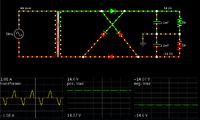R4Dt
Newbie level 4

- Joined
- Jan 17, 2013
- Messages
- 5
- Helped
- 0
- Reputation
- 0
- Reaction score
- 0
- Trophy points
- 1,281
- Location
- germany
- Activity points
- 1,351
Hi Forum. I'm new here. I just occasionally need some help on electronic topics...
I'm a Pro-musician, but always had a weak side for electronics too.
Lately I got my hands dirty on "renovating" some old mixing-desks, and learned a lot of new things.
(also - some bad experiences).
Now, I have this old H|H-desk standing here, but the original ("dual-coil") transformer is dead.
Normally it is has a rotary-switch on the back to select the voltage. (110 / 220 V).
Since I don't need that, I'm thinking to simply remove it.
Also - I happen to have a rather nice Single-coil transformer that I that I would like to put in instead.
Now, since I really don't know the rules of POWER-SUPPLIES, and how they are "installed" correctly, I just wanted someone that knows things
to give me blessings for my project.
It's really nothing wild, I think.
- but then again, I could be wildly mistaken!
I'll try to explain the givens:
Desk has a 2-coil transf. (??) 1A
- it has 4 pins on one coil, and 3 pins on the other.
(See schematics).
The one I've bought has 4 pins;
0 / 220V / 0 / 24V
// Primary: 220V - 0,2 A
Second. 24V - 1,3 A
CAN I replace the old (malfunctioning)one with this one?
Please try to explain for me the DOs and DON'Ts if there are some, since I want to learn...
Thanks.
I'm a Pro-musician, but always had a weak side for electronics too.
Lately I got my hands dirty on "renovating" some old mixing-desks, and learned a lot of new things.
(also - some bad experiences).
Now, I have this old H|H-desk standing here, but the original ("dual-coil") transformer is dead.
Normally it is has a rotary-switch on the back to select the voltage. (110 / 220 V).
Since I don't need that, I'm thinking to simply remove it.
Also - I happen to have a rather nice Single-coil transformer that I that I would like to put in instead.
Now, since I really don't know the rules of POWER-SUPPLIES, and how they are "installed" correctly, I just wanted someone that knows things
to give me blessings for my project.
It's really nothing wild, I think.
- but then again, I could be wildly mistaken!
I'll try to explain the givens:
Desk has a 2-coil transf. (??) 1A
- it has 4 pins on one coil, and 3 pins on the other.
(See schematics).
The one I've bought has 4 pins;
0 / 220V / 0 / 24V
// Primary: 220V - 0,2 A
Second. 24V - 1,3 A
CAN I replace the old (malfunctioning)one with this one?
Please try to explain for me the DOs and DON'Ts if there are some, since I want to learn...
Thanks.




